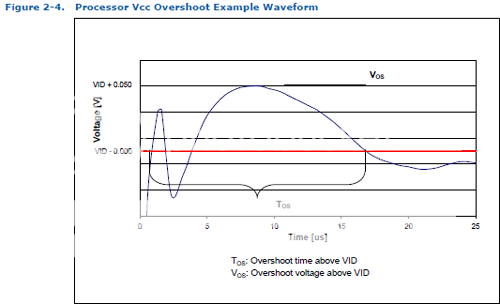From a purest standpoint I am not pro-LLC, I'm actually against it. I know what voltage spikes do to an IC. But in the non-academic realm, when we reduce this to the practical, LLC is just not the devil that laypeople like to make it out to be in forum settings like these. It is this over-attribution of fear and loathing for LLC that I find puzzling, so that is what I find myself following up on more so than the questions of how bad (or not) it is in reality.
That said, as far as I can determine, nowadays you technically can't overvolt an Intel or an AMD out of spec and invalidate the warranty because there are no voltage specifications for them in the first place. Period.
And if you have bought the latest AMD chip there is no way to technically overheat them and invalidate your warranty either, because a thermal spec doesn't exist for Vishera FX CPUs.
I was being facetious about the offset stuff in my comments way above. I realize my kind of humor is probably not mixing well with the text I'm typing here in this thread, I'm re-reading my posts now and am realizing they lack all the usual sarcastic emoticons I try to liberally pepper my posts with. So lord only knows just how offensive or argumentative you took my post(s), if you thought I was being a dick or something then I apologize, that wasn't at all what I had in my mind when I was drafting those responses to your posts. I have no beef with you whatsoever.
Not that you could, because the search here in these forums sucks horribly, but if you found my early posts on LLC I was staunchly against it. I have only changed my opinion recently (last 2-3 yrs) because the implementation have improved, they are not the crude implementations they were out there 5 yrs ago, they are more refined and do far less damage now (unless people do silly stuff like enabling the extreme setting in the BIOS

).
FWIW, to me the trade-offs you were referencing are pretty much half of one, six of the other.
At any rate, was just enjoying a bit of mental engagement is all. Its xmas eve and I've had a few, get to go "make a trip to the store" in an hour or so as my excuse for stepping out of the house so I can side-step into that garage and put on the santa suit for entertaining the kids with old "Santa's here!" routine

They get a visit from Santa before they go to bed on xmas eve, complete with a few of their presents as requested on their santa wish lists, and then Santa comes back and fills their stockings with goodies after they go to sleep. It is fun but I think this year they are going to figure out it is dad in that santa suit :hmm:



